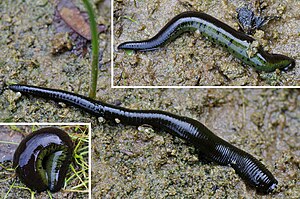Leeches
| Leeches | ||||||||||
|---|---|---|---|---|---|---|---|---|---|---|

Horse leech ( Haemopis sanguisuga ) |
||||||||||
| Systematics | ||||||||||
|
||||||||||
| Scientific name | ||||||||||
| Hirudinea | ||||||||||
| Lamarck , 1818 |
The leeches (Hirudinea) are one of the two subclasses of the belt worms (Clitellata), which in turn belong to the annelid worms . They comprise around 300 species, most of which live in fresh water and around 20% in sea and brackish water. Landing leeches occur in moist, predominantly tropical forests .
Body features
Leeches are very specialized, derived annelids. They have a fixed number of segments, which varies depending on the order (Branchiobdellida 15, Acanthobdellida 29, Euhirudinea 34). After the formation of the rear suction cup, there are no more segments, so that their number does not increase with age. The suction cups are combinations of several segments; they are very muscular and rich in glands. The Coelom sacs, which occur in each segment of the original annelid worms , are only created in the embryo and are dissolved in the adult animal. All that remains is a sewer system. The secondary curling also blurs the original segmentation. The eponymous characteristic of the belt worms (clitellata), the clitellum , can only be seen in the leeches during reproduction. In the parasitic species, the intestine forms large blind sacs in which blood is stored and digested.
Internal system
- Bristle leech (Acanthobdellida); only two species, Acanthobdella peledina and Acanthobdella livanovi (syn. Paracanthobdella livanovi ) parasitize on salmonids and are the only flukes equipped with bristles (on the front 5 segments).
-
Brushless leeches
- Branchiobdellida ; 150 species, 0.8–10 mm long. They live on the gills and surfaces of freshwater crabs and probably feed primarily on small algae and small animals that they find on the surface of their host animals. However, some species are parasitic.
-
Hirudinida (Euhirudinea); Body divided into 34 segments, 4 of which form the front suction cup and 7 form the rear suction cup. The sexual opening of the males is in the ninth segment, that of the females in the tenth segment. The Coelom has a continuous canal system.
- Rüsselegel (Rhynchobdelliformes), with muscular, ausstoßbarem trunk.
-
Trunkless leeches
- Kieferegel (Gnathobdelliformes), with muscular pines that with Cuticulazähnchen are occupied.
- Schlundegel (Pharyngobdelliformes), with a long, muscular pharynx that cannot be everted.


In the classical system, the results of the phylogenetic studies are implemented in different ways. A different number of ranks are switched in between in order to depict the historical context. In the following the systematics of the leeches within the tribe of annelids (Annelida) according to Westheide / Rieger:
- Polychaeta class
- Class Clitellata
- Subclass Oligochaeta
- Subclass Hirudinea
- Order Acanthobdellida
- Order Branchiobdellida
- Order Hirudinida (Euhirudinea)
- Subordination Rhynchobdelliformes (trunk leech)
- Subordination Gnathobdelliformes (jaw rule)
- Subordination Pharyngobdelliformes (Schlundegel)
Types (selection)
- Rhynchobdelliformes (trunk leech):
- Small snail leech ( Alboglossiphonia heteroclita )
- Great snail leech ( Glossiphonia complanata )
- Four-eyed flat cone ( Hemiclepsis marginata )
- Ozobranchus jantseanus
- Common fish leech ( Piscicola geometra )
- Turtle leech ( Placobdella costata )
- Duck leech ( Theromyzon tessulatum )
- European flat leech ( Helobdella europaea )
- Gnathobdelliformes (jaw rule):
- Horse leech ( Haemopis sanguisuga )
- Medicinal leech ( Hirudo medicinalis )
- Tyrant obdella rex
- European country leech ( Xerobdella lecomtei ), endemic to Styria
- Mediterranean medicinal leech ( Hirudo verbana )
- Pharyngobdelliformes:
- Eight-eyed throat gel (dog gel or roller gel; Erpobdella octoculata )
- Freiburg Bächle leech ( Trocheta intermedia )
Individual evidence
- ↑ Wilfried Westheide, Reinhard Rieger: Special Zoology. Part 1: Protozoa and invertebrates. 2nd Edition. Spektrum Akademischer Verlag, Heidelberg / Berlin 2007, ISBN 978-3-8274-1575-2 , pp. 430–437.
literature
- Wilfried Westheide , Reinhard Rieger: Special Zoology. Part 1: Protozoa and invertebrates. 2nd Edition. Spectrum Academic Publishing House, Heidelberg / Berlin 2007, ISBN 978-3-8274-1575-2 .
- Andreas Hassl: Medical Entomology & Hirudineology & Vertebratology. 2nd German edition v6.3. Script for the lecture WS 2011/12. Self-published, Vienna, A. 25 pp.
Web links
- Hirudinea and subordinate units in Fauna Europaea
- Video: Feeding in leeches (Hirudinea) . Institute for Scientific Film (IWF) 1981, made available by the Technical Information Library (TIB), doi : 10.3203 / IWF / C-1416 .
